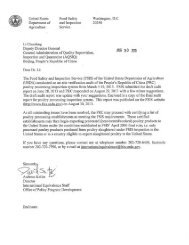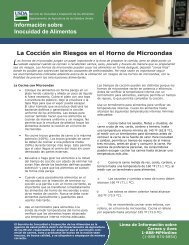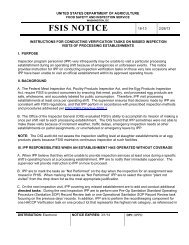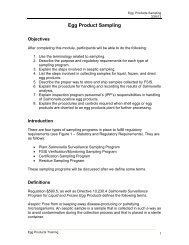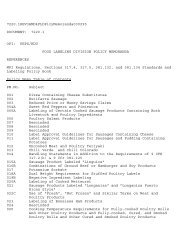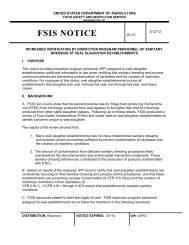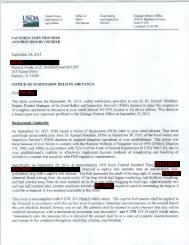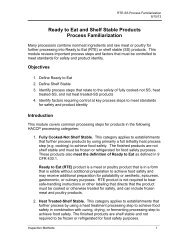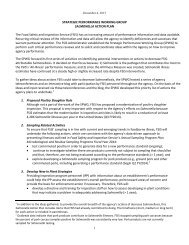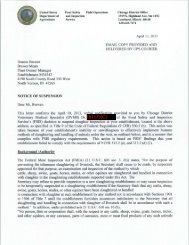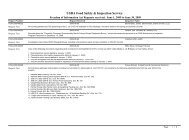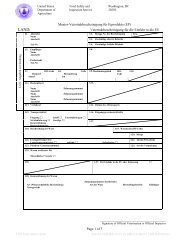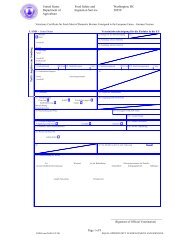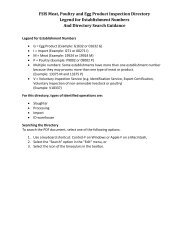How Temperatures Affect Food - Food Safety and Inspection Service ...
How Temperatures Affect Food - Food Safety and Inspection Service ...
How Temperatures Affect Food - Food Safety and Inspection Service ...
Create successful ePaper yourself
Turn your PDF publications into a flip-book with our unique Google optimized e-Paper software.
United States Department of Agriculture<br />
<strong>Food</strong> <strong>Safety</strong> <strong>and</strong> <strong>Inspection</strong> <strong>Service</strong><br />
<strong>Food</strong> <strong>Safety</strong> Information<br />
<strong>How</strong> <strong>Temperatures</strong> <strong>Affect</strong> <strong>Food</strong><br />
Last night I left cooked roast beef on the counter to cool before refrigerating, but fell asleep <strong>and</strong> discovered it<br />
this morning. I immediately put it in the refrigerator. Since the meat is cooked, shouldn’t it be safe to eat?<br />
The U.S. Department of Agriculture’s Meat <strong>and</strong> Poultry<br />
Hotline receives similar calls every day from consumers<br />
who are confused about how to keep their food safe.<br />
The answer to this caller’s question is that the roast<br />
beef should be thrown out. Why? Because leaving food<br />
out too long at room temperature can cause bacteria<br />
(such as Staphylococcus aureus, Salmonella Enteritidis,<br />
Escherichia coli O157:H7, <strong>and</strong> Campylobacter) to grow<br />
to dangerous levels that can cause illness.<br />
Bacteria exist everywhere in nature. They are in the<br />
soil, air, water <strong>and</strong> the foods we eat. When bacteria<br />
have nutrients (food), moisture, time <strong>and</strong> favorable<br />
temperatures, they grow rapidly increasing in<br />
numbers to the point where some can cause illness.<br />
Underst<strong>and</strong>ing the important role temperature plays in<br />
keeping food safe is critical. If we know the temperature<br />
at which food has been h<strong>and</strong>led, we can then answer<br />
the question, “Is it safe?”<br />
The “Danger Zone” (40 °F-140 °F)<br />
Bacteria grow most rapidly in the range of temperatures<br />
between 40 ° <strong>and</strong> 140 °F, doubling in number in as<br />
little as 20 minutes. This range of temperatures is often<br />
called the “Danger Zone.” That’s why the Meat <strong>and</strong><br />
Poultry Hotline advises consumers to never leave food<br />
out of refrigeration over 2 hours. If the temperature is<br />
above 90 °F, food should not be left out more than 1<br />
hour.<br />
If you are traveling with cold food, bring a cooler<br />
packed with plenty of ice, frozen gel packs or another<br />
a cold source. If you are cooking, use a hot campfire or<br />
portable stove. It is difficult to keep foods hot without<br />
a heat source when traveling, so it’s best to cook foods<br />
before leaving home, cool them, <strong>and</strong> transport them<br />
cold.<br />
Cooking<br />
The <strong>Food</strong> <strong>Safety</strong> <strong>and</strong> <strong>Inspection</strong> <strong>Service</strong> (FSIS) is the public health agency<br />
in the U.S. Department of Agriculture responsible for ensuring that the nation’s<br />
commercial supply of meat, poultry, <strong>and</strong> egg products is safe, wholesome,<br />
<strong>and</strong> correctly labeled <strong>and</strong> packaged.<br />
Raw meat <strong>and</strong> poultry should always be cooked to a<br />
safe minimum internal temperature. When roasting<br />
meat <strong>and</strong> poultry, use an oven temperature no lower<br />
than 325 °F. Use a food thermometer to assure that<br />
meat <strong>and</strong> poultry have reached a safe minimum internal<br />
temperature.<br />
• Cook all raw beef, pork, lamb <strong>and</strong> veal steaks,<br />
chops, <strong>and</strong> roasts to a minimum internal<br />
temperature of 145 °F as measured with a food<br />
thermometer before removing meat from the heat<br />
source. For safety <strong>and</strong> quality, allow meat to rest for<br />
at least three minutes before carving or consuming.<br />
For reasons of personal preference, consumers may<br />
choose to cook meat to higher temperatures.<br />
• Cook all raw ground beef, pork, lamb, <strong>and</strong> veal to<br />
an internal temperature of 160 °F as measured with<br />
a food thermometer.<br />
• Cook all poultry to a safe minumum internal<br />
temperature of 165 °F as measured with a food<br />
thermometer.<br />
If raw meat <strong>and</strong> poultry have been h<strong>and</strong>led safely, using<br />
the above preparation recommendations will make<br />
them safe to eat. If raw meats have been mish<strong>and</strong>led<br />
(left in the “Danger Zone” too long), bacteria may grow<br />
<strong>and</strong> produce toxins which can cause foodborne illness.<br />
Those toxins that are heat resistant are not destroyed<br />
by cooking. Therefore, even though cooked, meat <strong>and</strong><br />
poultry mish<strong>and</strong>led in the raw state may not be safe to<br />
eat even after proper preparation.<br />
USDA Meat & Poultry Hotline<br />
1-888-MPHotline<br />
(1-888-674-6854)<br />
USDA Photo
<strong>How</strong> <strong>Temperatures</strong> <strong>Affect</strong> <strong>Food</strong><br />
Storing Leftovers<br />
One of the most common causes of foodborne illness is<br />
improper cooling of cooked foods. Because bacteria are<br />
everywhere, even after food is cooked to a safe internal<br />
temperature, they can be reintroduced to the food <strong>and</strong><br />
then reproduce. For this reason leftovers must be put<br />
in shallow containers for quick cooling <strong>and</strong> refrigerated<br />
within 2 hours.<br />
Reheating<br />
<strong>Food</strong>s should be reheated thoroughly to an internal<br />
temperature of 165 °F or until hot <strong>and</strong> steaming. In<br />
the microwave oven, cover food <strong>and</strong> rotate so it heats<br />
evenly. Follow manufacturer’s instructions for st<strong>and</strong><br />
time for more thorough heating. In the absence of<br />
manufacturer’s instructions, at least a two minute<br />
st<strong>and</strong> time should be allowed.<br />
<strong>Food</strong> <strong>Safety</strong> Questions?<br />
Call the USDA Meat & Poultry Hotline<br />
If you have a question about<br />
meat, poultry or egg products,<br />
call the USDA Meat<br />
<strong>and</strong> Poultry<br />
Hotline toll free at<br />
1-888-MPHotline<br />
or 1-888-674-6854.<br />
The hotline is open<br />
year-round Monday<br />
through Friday<br />
Send E-mail questions to MPHotline.fsis@usda.gov.<br />
FSIS encourages the reprint <strong>and</strong> distribution of this publication for food safety<br />
education purposes. <strong>How</strong>ever, USDA symbols or logos may not be used separately to<br />
imply endorsement of a commercial product or service.<br />
Cold Storage <strong>Temperatures</strong><br />
Properly h<strong>and</strong>led food stored in a freezer at 0 °F will be<br />
safe. Freezing keeps food safe by slowing the movement of<br />
molecules, causing bacteria to enter<br />
a dormant stage. Once thawed, these bacteria can again<br />
become active <strong>and</strong> multiply to levels that may lead to<br />
foodborne illness. Because bacteria on these foods will grow<br />
at about the same rate as they would on fresh food, thawed<br />
foods should be h<strong>and</strong>led as any other perishable food.<br />
A temperature of 40 °F should be maintained in the<br />
refrigerator. In contrast to freezer storage, perishable foods<br />
will gradually spoil in the refrigerator. Spoilage bacteria will<br />
make themselves known in a variety of ways. The food may<br />
develop an uncharacteristic odor, color <strong>and</strong>/or become sticky<br />
or slimy. Molds may also grow <strong>and</strong> become visible. Bacteria<br />
capable of causing foodborne illness either don’t grow or<br />
grow very slowly at refrigerator temperatures. An appliance<br />
thermometer should always be used to verify that the<br />
temperature of the unit is correct.<br />
Safe food-h<strong>and</strong>ling practices are a good defense against<br />
foodborne illness. Because we know how different<br />
temperatures affect the growth of bacteria in our food,<br />
we can protect ourselves <strong>and</strong> our families from foodborne<br />
illnesses by properly h<strong>and</strong>ling, cooking <strong>and</strong> storing foods at<br />
safe temperatures.<br />
from 10 a.m. to 4 p.m. EST<br />
(English or Spanish).<br />
Listen to timely<br />
recorded food safety<br />
messages at the<br />
same number<br />
24 hours a day.<br />
Check out the<br />
FSIS Web site at<br />
www.fsis.usda.gov<br />
Ask Karen!<br />
FSIS’ automated response<br />
system can provide food safety<br />
information<br />
24/7 <strong>and</strong> a<br />
live chat<br />
during<br />
Hotline<br />
hours.<br />
AskKaren.gov<br />
PregunteleaKaren.gov<br />
The USDA is an equal opportunity<br />
provider <strong>and</strong> employer.<br />
Revised May 2011



